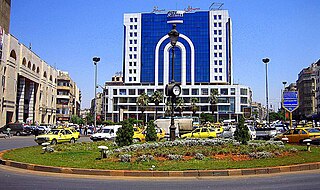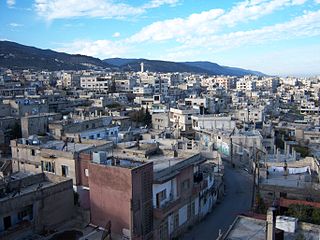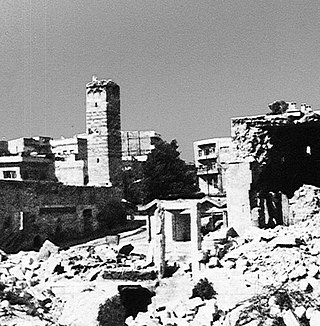
Homs, known in pre-Islamic Syria as Emesa, is a city in western Syria and the capital of the Homs Governorate. It is 501 metres (1,644 ft) above sea level and is located 162 kilometres (101 mi) north of Damascus. Located on the Orontes River, Homs is also the central link between the interior cities and the Mediterranean coast.

The Ayyubid dynasty, also known as the Ayyubid Sultanate, was the founding dynasty of the medieval Sultanate of Egypt established by Saladin in 1171, following his abolition of the Fatimid Caliphate of Egypt. A Sunni Muslim of Kurdish origin, Saladin had originally served the Zengid ruler Nur ad-Din, leading Nur ad-Din's army in battle against the Crusaders in Fatimid Egypt, where he was made Vizier. Following Nur ad-Din's death, Saladin was proclaimed as the first Sultan of Egypt by the Abbasid Caliphate, and rapidly expanded the new sultanate beyond the frontiers of Egypt to encompass most of the Levant, in addition to Hijaz, Yemen, northern Nubia, Tarabulus, Cyrenaica, southern Anatolia, and northern Iraq, the homeland of his Kurdish family. By virtue of his sultanate including Hijaz, the location of the Islamic holy cities of Mecca and Medina, he was the first ruler to be hailed as the Custodian of the Two Holy Mosques, a title that would be held by all subsequent sultans of Egypt until the Ottoman conquest of 1517. Saladin's military campaigns in the first decade of his rule, aimed at uniting the various Arab and Muslim states in the region against the Crusaders, set the general borders and sphere of influence of the sultanate of Egypt for the almost three and a half centuries of its existence. Most of the Crusader states, including the Kingdom of Jerusalem, fell to Saladin after his victory at the Battle of Hattin in 1187. However, the Crusaders reconquered the coast of Palestine in the 1190s.

Tripoli is the largest and most important city in northern Lebanon and the second-largest city in the country. Situated 81 km (50 mi) north of the capital Beirut, it is the capital of the North Governorate and the Tripoli District. Tripoli overlooks the eastern Mediterranean Sea, and it is the northernmost seaport in Lebanon. The city is predominantly inhabited by Sunni Muslims, with smaller populations of Alawites and Christians, including Maronites and Armenians among others.

Hama is a city on the banks of the Orontes River in west-central Syria. It is located 213 km (132 mi) north of Damascus and 46 kilometres (29 mi) north of Homs. It is the provincial capital of the Hama Governorate. With a population of 996,000, Hama is the fourth-largest city in Syria after Damascus, Aleppo and Homs.

Masyaf is a city in northwestern Syria. It is the center of the Masyaf District in the Hama Governorate. As of 2004, Masyaf had a religiously diverse population of approximately 22,000 Ismailis, Alawites and Christians. The city is well known for its large medieval castle, particularly its role as the headquarters of the Nizari Ismailis and their elite Assassins unit.

Al-Rastan is the third largest city in the Homs Governorate, located 25 kilometers (16 mi) north of its administrative capital Homs and 22 kilometers (14 mi) from Hama. Nearby localities include Talbiseh and al-Ghantu to the south, al-Zaafaraniyah and al-Mashrafah to the southeast, Murayj al-Durr to the northeast, Tumin to the north, Deir al-Fardis to the northwest and Kafr Nan and the Houla village cluster to the west. Ar-Rastan had a population of nearly 40,000 in 2004.

The known history of Gaza spans 4,000 years. Gaza was ruled, destroyed and repopulated by various dynasties, empires, and peoples. Originally a Canaanite settlement, it came under the control of the ancient Egyptians for roughly 350 years before being conquered and becoming one of the Philistines' principal cities. Gaza became part of the Assyrian Empire around 730 BC. Alexander the Great besieged and captured the city in 332 BC. Most of the inhabitants were killed during the assault, and the city, which became a center for Hellenistic learning and philosophy, was resettled by nearby Bedouins. The area changed hands regularly between two Greek successor-kingdoms, the Seleucids of Syria and the Ptolemies of Egypt, until it was besieged and taken by the Hasmoneans in 96 BC.
The following is a timeline of the Syrian Civil War from May to August 2011, including the escalation of violence in many Syrian cities.

The Islamist uprising in Syria comprised a series of protests, assassinations, bombings, and armed revolts led by Sunni Islamists, mainly members of the Fighting Vanguard and, after 1979, the Muslim Brotherhood, from 1976 until 1982. The uprising aimed to establish an Islamic Republic in Syria by overthrowing the Ba'athist government, in what has been described by Ba'ath Party as a "long campaign of terror".

The 2011 siege of Hama was among the many nationwide crackdowns by the Syrian government during the Syrian revolution, the early stage of the Syrian civil war. Anti-government protests had been ongoing in the Syrian city of Hama since 15 March 2011, when large protests were first reported in the city, similar to the protests elsewhere in Syria. The events beginning in July 2011 were described by anti-government activists in the city as a "siege" or "blockade".
The following is a timeline of the Syrian uprising from September to December 2011. This period saw the uprising take on many of the characteristics of a civil war, according to several outside observers, including the United Nations Commission on Human Rights, as armed elements became better organized and began carrying out successful attacks in retaliation for the ongoing crackdown by the Syrian government on demonstrators and defectors.
The following is a timeline of the history of the city of Damascus, Syria.
The following is a timeline of the history of the city of Aleppo, Syria.
The following is a timeline of the history of the city of Tripoli, Libya.
The following is a timeline of the history of the city of Basra, Iraq.
The following is a timeline of the history of Kabul, Afghanistan.
The following is a timeline of the history of the city of Herat, Afghanistan.
Al-Muzaffar II Mahmud was the Ayyubid emir of Hama first in 1219 and then restored in 1229–1244. He was the son of al-Mansur Muhammad and the older brother of al-Nasir Kilij Arslan.
The following is a timeline of the history of the city of Homs, Syria.












